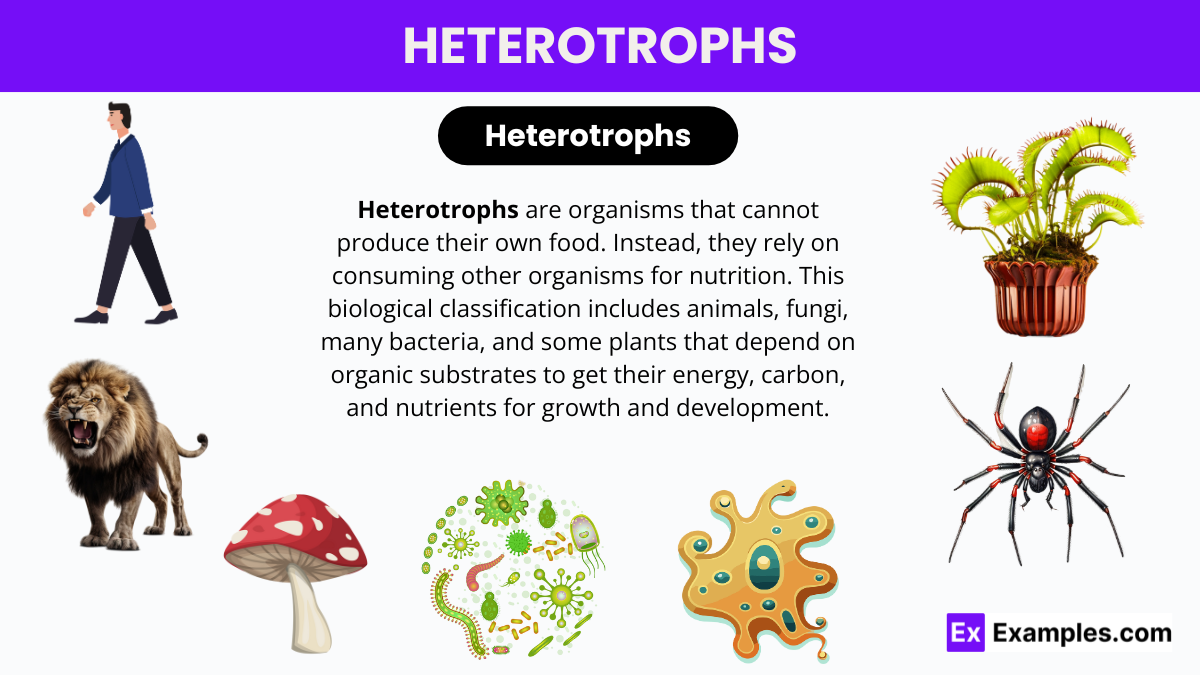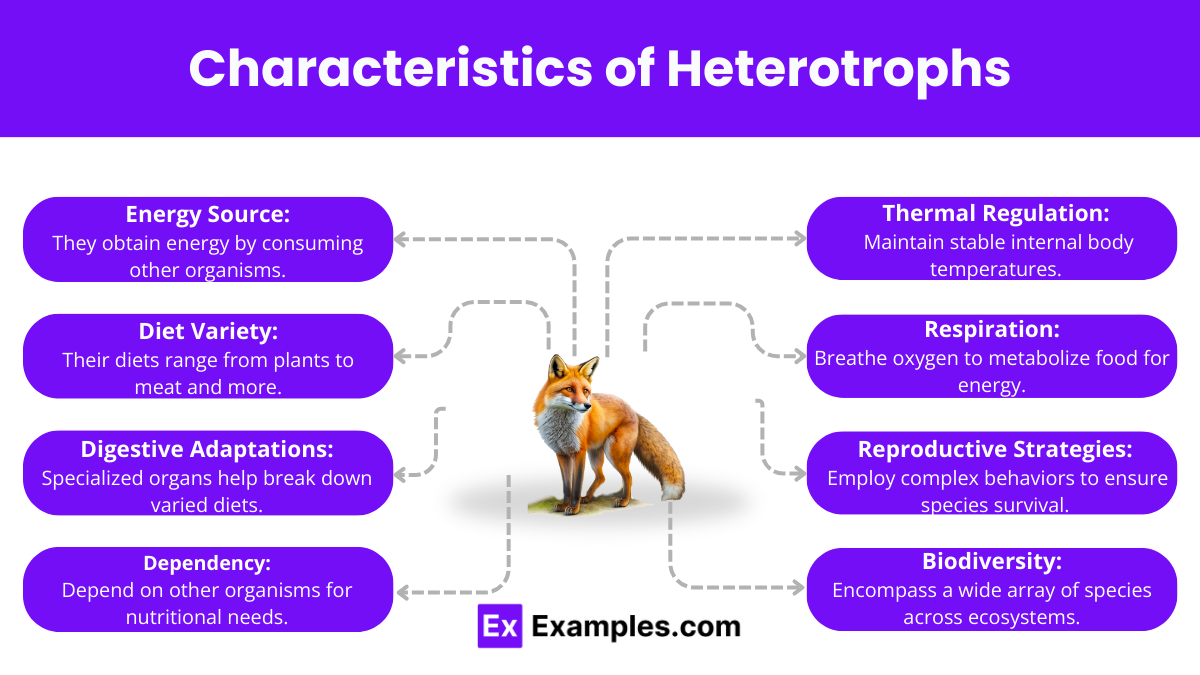What is a heterotroph?
An organism that produces its own food
An organism that consumes other organisms for energy
An organism that performs photosynthesis
An organism that only lives in water


Heterotrophs are organisms that obtain their energy and nutrients by consuming other organisms, making them vital consumers within ecological systems. Unlike autotrophs, which produce their own food through photosynthesis, heterotrophs include animals, fungi, and some bacteria that rely on organic sources of carbon. They play diverse roles in food chains, from herbivores and carnivores to omnivores and detritivores, each contributing to the cycling of nutrients and energy through ecosystems.
A heterotroph is an organism that cannot synthesize its own food and instead relies on the intake of other organisms, both plant and animal, for energy and nutrients. Derived from the Greek words hetero, meaning “other”, and trophe, meaning “nourishment”, heterotrophs are crucial components of the food chain, sustaining themselves directly or indirectly on autotrophs, the ecosystem’s primary producers.
Heterotrophs are primarily categorized based on their dietary habits into herbivores, carnivores, omnivores, and decomposers.
Herbivores are animals that consume plant material. This group includes a wide range of mammals like deer and elephants, as well as insects such as caterpillars and certain species of birds. They have adaptations such as specialized teeth for grinding leaves and digestive systems capable of processing fibrous plant matter.
Carnivores are predators that eat other animals. They are equipped with sharp teeth and claws for capturing and dismembering their prey. Carnivores can be further divided into obligate carnivores, which solely depend on meat, and facultative carnivores, which consume meat as a major part of their diet but can also eat non-animal foods.
Omnivores can digest both plant and animal matter, giving them a versatile diet that can adapt to available food sources. This dietary flexibility helps them to survive in diverse environments.
Decomposers break down dead organic material, returning nutrients to the ecosystem. This group includes bacteria and fungi, which decompose everything from fallen leaves to animal carcasses, playing an essential role in nutrient cycling and energy flow.
Heterotrophs form the various levels of consumers in the ecological food chain, directly or indirectly relying on the organic matter produced by autotrophs. They play vital roles in transferring energy from one trophic level to another, ensuring the flow of nutrients through ecosystems. This interdependency highlights the balance between producer and consumer dynamics, crucial for maintaining the health and sustainability of ecosystems globally.

However, there are some interesting exceptions in the plant world where certain plants are heterotrophic. These plants have adapted unique methods to obtain nutrients from external sources. Here are some examples of heterotrophic plants and their distinctive feeding mechanisms:
Parasitic plants rely on other plants for their nutritional requirements. They connect to their host plants via a specialized structure called a haustorium, which penetrates the host plant’s tissues to draw water and nutrients. Some well-known parasitic plants include:
These plants derive their nutrients from fungi that are attached to the roots of other plants. Mycoheterotrophs are usually found in dark environments, like dense forests, where sunlight is scarce. They are entirely reliant on their relationship with fungi to obtain the sugars and nutrients produced by other plants. Examples include:
Carnivorous plants supplement their nutrient intake, particularly nitrogen, by capturing and digesting insects and other small animals. These plants typically grow in areas with nutrient-poor soil. Examples of carnivorous plants include:
Heterotrophs are organisms that obtain energy by consuming other living or deceased organisms, unable to produce their own food.
Heterotrophs consume organic material for energy, while autotrophs produce their own nutrients using light or chemical energy.
Not all heterotrophs are animals; this group also includes fungi, many bacteria, and some protozoans that consume organic material.
In biology, an autotroph is an organism that produces its own food using light (photosynthesis) or chemical energy (chemosynthesis), serving as primary producers in ecosystems.
Text prompt
Add Tone
10 Examples of Public speaking
20 Examples of Gas lighting
What is a heterotroph?
An organism that produces its own food
An organism that consumes other organisms for energy
An organism that performs photosynthesis
An organism that only lives in water
Which of the following is a heterotroph?
Grass
Mushroom
Algae
Cyanobacteria
Heterotrophs are divided into several categories. Which one is NOT a category of heterotrophs?
Herbivores
Carnivores
Omnivores
Autotrophs
Which type of heterotroph exclusively eats plants?
Carnivore
Herbivore
Omnivore
Decomposer
Which of the following is an example of a heterotrophic process?
Photosynthesis
Nitrogen fixation
Cellular respiration
Chemosynthesis
Which heterotroph consumes both plants and animals?
Herbivore
Carnivore
Omnivore
Decomposer
Which of the following best describes decomposers?
Heterotrophs that break down dead organic material
Heterotrophs that only eat meat
Autotrophs that produce their own food
Heterotrophs that only eat plants
How do heterotrophs differ from autotrophs in terms of energy acquisition?
Heterotrophs use sunlight for energy
Heterotrophs produce their own food
Heterotrophs consume organic material for energy
Heterotrophs use inorganic compounds for energy
Which of these organisms is NOT a heterotroph?
Lion
Human
Oak tree
Earthworm
What role do heterotrophs play in the food web?
Primary producers
Consumers
Photosynthesizers
Light absorbers
Before you leave, take our quick quiz to enhance your learning!

